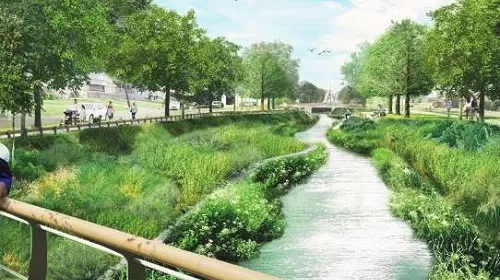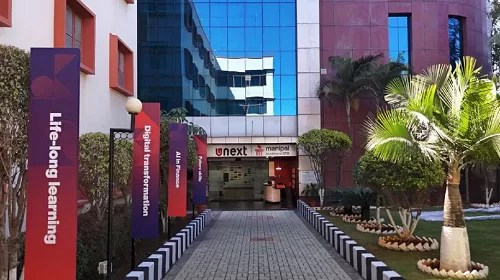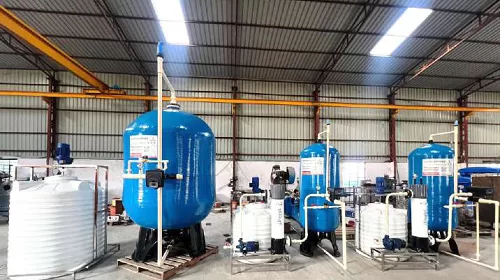The escalating challenges posed by climate change, urbanization, and environmental degradation have been posing a grave risk towards urban sustainability. The rise in extreme weather events, such as heavy rainfall and storms, has intensified the risk of urban flooding. Cities are experiencing higher temperatures due to the absorption of heat by concrete and asphalt. Irregularities in rain fall have been causing drought in many parts of the world every year. The traditional grey infrastructure like concrete drains and storm water systems is often rigid and unable to adapt to fluctuating environmental conditions. The aging of the infrastructure in many cities cannot cope with the increased frequency and intensity of storms. Further, the old urban infrastructure often exacerbates runoff pollution and disrupts natural ecosystems. To tackle such challenges of traditional infrastructure, Blue–Green Infrastructure (BGI) has been paving a way towards development of a sustainable urban infrastructure. BGI is a sustainable urban development approach that integrates water management (blue) with vegetated spaces (green) to create resilient, multifunctional landscapes. It offers a holistic method to managing urban water cycles, enhancing biodiversity, and improving urban environments.
BLUE-GREEN INFRASTRUCTURE
Blue-green infrastructure is a planning and design strategy that combines water management and vegetation systems to create sustainable and livable urban spaces. It mainly encompasses 2 components:
- Blue Components: Rivers, lakes, ponds, wetlands, storm water systems, and green roofs designed to manage water sustainably.
- Green Components: Parks, gardens, urban forests, green roofs, and walls that promote biodiversity and improve air quality.
The integration of these systems helps in managing water resources, reducing urban flooding, improving biodiversity, and enhancing human well-being.
STRATEGIES TO IMPLEMENT BLUE-GREEN INFRASTRUCTURE
The effective implementation of green and blue infrastructure requires targeted strategies and the integration of proven concepts. The forthcoming section illustrates how utilizing a blue-green infrastructure strategy can make towns and cities more resilient to environmental influences and how the quality of life of its residents can be continuously improved
- Urban Trees, Forests and Parks: A tree canopy acts as the lungs of a city by absorbing CO2 and releasing oxygen. Urban parks and forests are created by planting and maintaining trees in urban areas. It not only offers people a refuge but is also crucial for local animal and plant conservation. By improving air quality and providing shade and cooling, it also mitigates the urban heat island effect and improves microclimates in densely built-up areas.
- Green Roofs and Walls: Created by developing vegetated surfaces on building roofs and walls, they thermally insulate buildings and reduce heat absorption. Green roofs promote biodiversity by offering birds, insects and small mammals with habitats. They manage storm water by absorbing precipitation and relieve sewer systems in this way. Green roofs also play a role in improving air quality.
- Blue Roofs: They are designed to temporarily store rainwater to reduce runoff. By storing the rain water temporarily and releasing in controlled manner, it can reduce urban flooding. Also known as Water Squares, they also render recreational spaces and enhance the urban aesthetics.
- Permeable Pavements: By using cobblestones in pavements of paths, drive ways and car parks, permeable surfaces are constructed to allow water infiltration through porous materials which reduces storm water runoff and thus the risk of localized flooding. Also, it helps replenishing ground water and supports the natural dynamics of the water cycle.
- Shoreline zones: The restoration of natural spaces like river banks and shorelines protects against erosion. As natural ecosystems return, local plants improve water quality as they filter storm water flows. Additionally, they create important habitats for creatures on land and in the water. These green and blue spaces also provide attractive local recreational areas and increase the quality of life for local communities.
- Constructed Wetlands: These are artificial water ecosystems which imitate the function of natural wetlands and offer efficient solutions for water purification. They act as biological water treatment systems, whereby green cover and microorganisms remove pollutants from water. At the same time, they create an important habitat for many types of animals and plants as well as provide a basis for research and education, thereby enhance biodiversity and carbon sequestration.
- Rain Gardens: A rain garden is a specially planted shallow and vegetated basin that captures rainwater from roofs and paved surfaces. They reduce drainage in the sewer system effectively and help replenish ground water. They improve not only urban biodiversity but also increase awareness about sustainable rainwater utilisation. Their importance lies in their main advantages of improved water quality through filtration and enhanced aesthetics and biodiversity.
- Bioswales: Bioswales are linear, vegetated channels designed to convey and filter storm water. They reduce runoff and erosion as well as improve water quality.
- Riparian Buffers: Riparian buffers are strips of vegetation (trees, shrubs or grass) planted next to streams or other waterbodies. By planting vegetation along streams, space is created between the water and upland land uses, which helps protect the water quality and stream habitat. It brings about streambank stabilization, erosion and sediment control. It also reduces the impact from floods and renders habitat and food for wildlife and pollinators, in addition to bringing shade for streams.
- Green Corridors: A blue/green corridor is a sustainable design solution that uses a river and adjacent lands to establish an interconnected passageway between natural habitats. It promotes wildlife movement, enhances biodiversity and improves air and water quality.
BENEFITS OF BLUE GREEN INFRASTRUCTURE
BGI presents nature-based solutions narrated in above section which help to reduce local flooding and thermal discomfort. These solutions are not only inspired and supported by nature, but they are cost-effective and provide environmental, social and economic benefits as well. BGI, therefore, can be considered as an umbrella for various other concepts.
BGI is not a mere new term used for many different meanings of urban green infrastructure, but it constitutes a new thematic approach to sustainable urban planning. This approach comprises all the approaches implemented for Sustainable cities, Eco cities, Healthy cities, Bio sensitive cities or Smart cities. The advantages of BGI could be broadly categorised in below listed areas.
- Improved Water Management: By incorporating permeable surfaces and natural water pathways, BGI reduces the risk of flooding. It also captures and filters storm water, reducing the burden on traditional drainage systems.
- Enhanced Biodiversity: Urban green spaces provide habitats for a wide range of species, promoting biodiversity in cities. Wetlands and ponds offer critical habitats for amphibians, birds, and aquatic species.
- Urban Cooling: Vegetation and water bodies aid to natural cooling and thereby help mitigate the urban heat island effect. Increased tree canopies and shaded areas reduce surface temperatures.
- Improved Air Quality: The plants absorb pollutants and particulate matter, improving overall air quality. Vegetation also sequesters carbon dioxide, contributing to carbon reduction efforts.
- Social and Health Benefits: Access to green spaces promotes physical and mental well-being of the community. BGI could also promote various recreational opportunities and improve community cohesion.
- Economic Benefits: The rates of properties in areas with well-maintained green spaces rise appreciably. Also, the costs associated with flood damage and heat-related illnesses reduce to some extent. The energy bills of the households and offices get reduced due to the cooling effects of vegetation.
- Climate Resilience: BGI enhances the resilience of urban areas to climate-related events such as extreme heat, storms, droughts, carbon sequestration, flood, biodiversity, air quality etc.
CHALLENGES TO BLUE GREEN INFRASTRUCTURE
BGI is not a panacea for urban problems and may also entail some drawbacks or trade-offs. The cost in implementing BGI may not be adequately covered by public or private funding sources. Additionally, blue-green infrastructure may not always be compatible or complementary with existing or planned urban development and infrastructure, potentially creating conflicts or exacerbating social or environmental injustices. Moreover, there is uncertainty and variability in the design, implementation, and management of BGI which may reduce its effectiveness or create unintended consequences. Below listed are some of the challenges to BGI.
- Initial Costs and Maintenance: While BGI can provide long-term cost savings, initial implementation costs can be high. These costs may vary depending on the type, scale, and location of blue green infrastructure. Regular maintenance is essential to ensure functionality and aesthetic appeal.
- Space Constraints: Urban areas often face space limitations, making it challenging to implement largescale BGI projects.
- Community Engagement: Successful BGI projects require community buy-in and participation. Ambiguity about successful performance of BGI can become hindrance to involvement of community.
- Policy and Governance: Clear policies and regulations are needed to promote and support BGI implementation.
STRIKE A BALANCE
Blue Green Infrastructure is not a universal solution for urban challenges and needs careful planning, design, implementation, and management to maximize its advantages and reduce its disadvantages. To balance the benefits and drawbacks of BGI, it is important to assess the context and objectives, apply the principles of integrated and adaptive management, and engage and empower urban stakeholders. By conducting baseline studies, carrying out stakeholder analysis and cost-benefit analysis, a scenario should be planned to identify and evaluate the potential impacts and trade-offs of BGI.
CONCLUSION
Blue-green infrastructure offers a multifaceted approach to creating resilient and sustainable urban environments. By integrating water management and vegetation systems, BGI addresses key urban challenges related to flooding, heat, biodiversity loss, and air quality. Its role in mitigating the impacts of climate change is significant, offering solutions that enhance carbon sequestration, promote cooling, and improve overall urban resilience. As cities face increasing climate pressures, investing in blue-green infrastructure is a critical step toward building a sustainable and livable future.
By Dr. Mayur J Kapadia, Former AGM, Quality Control Dept, GNFC Ltd, Bharuch, Gujarat – TC Member & Resource Person, BIS – Trainer – Technical Writer ‘Elsevier’ Author





